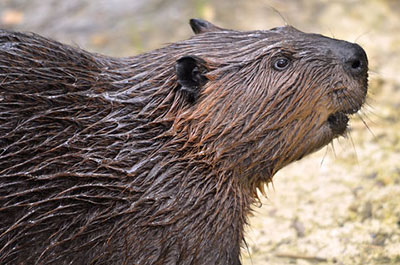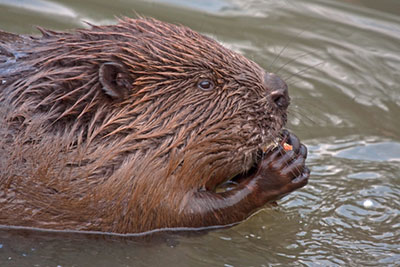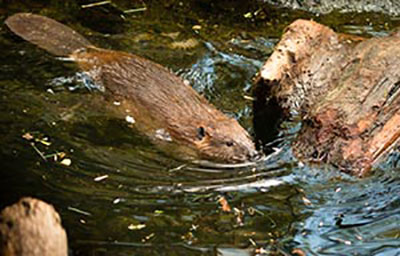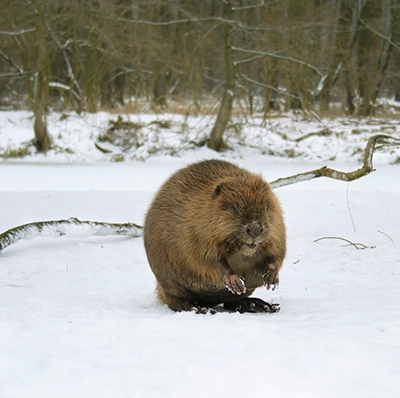Beaver Basics
By Amy Nelson

How many species of beaver exist?
It is estimated that roughly 30 genera of beaver once existed. Today, the beaver family (Castoridae) consists of only one genus (Castor),with two species: the North American beaver (Castor canadensis), and the Eurasian beaver (Castor fiber).
Where do beaver exist?

Beaver are believed to have existed throughout most of North America, Europe, and northern Asia. Before the arrival of the European fur trade to North America, it is estimated that the North American beaver population was anywhere between 55 and 400 million. By the end of the 19th century, however, that population was reduced to 100,000. The fur trade had also reduced Eurasian beaver populations to a few isolated sites in Germany, France, and southern Norway. Other small populations survived in Belarus, Russia, and Mongolia.
By the 20th century, an estimated 1200-1300 Eurasian beaver remained in the wild. Today, both species are very much on the rebound. Populations of Eurasian beaver are now established in France, Germany, Poland, southern Scandinavia, and central Russia. Reintroduction of the species happening in the British Isles. In 2008, there were estimated to be one million beaver in Europe. North American beaver populations are now estimated to be about 10 million and increasing, with beaver occurring throughout most of Canada, Alaska, the continental U.S., and portions of northern Mexico.
What do beaver look like?

Both species of beaver have thick, brownish fur consisting of both short hair for warmth and long hair for waterproofing. Their hind feet are webbed, which help propel the animal through the water. Their five-fingered forepaws, which are smaller and more dexterous, enable them grab sticks, hold them for chewing, and build. Beaver eat cambium (the soft tissue that grows beneath tree bark), leaves, roots, and tubers. The beaver’s unique oral adaptions also allow it to build. Long, sharp incisors enable the beaver to cut into trees and woody vegetation. Their lips, which seal behind the incisors, allow for underwater gnawing. When the beaver is underwater, a clear membrane protects its eyes while valves in the beaver’s ears and nose close to seal out water.

The beaver’s wide, flat, scale-covered, paddle-shaped tail serves as rudder for swimming, a prop for balance when cutting trees, and, when slapped on the surface of water, a communication device. Large castor (anal scent) glands produce castoreum, a yellowish-brown oil that is deposited on mud scent mounds to mark territory. Both species grow to be approximately 2.5 to 3 feet in length and up to 60 pounds in weight.
How big is a beaver family?
Beaver colonies typically can range from 1-10 individuals, and often (although not always) consist of a breeding pair, two yearlings (who will likely disperse around the age of two), and two kits.
 Where do beaver build dams?
Where do beaver build dams?
Beaver prefer to build dams on small- to medium- sized, low-gradient streams, but they will also build on lakes, wetlands, and estuaries if their habitat can be improved by retaining additional water.
Do beaver need to have dams?
No, beaver need deep water to avoid predation. If deep water is available, they do not need to build a dam, and will build their lodge in the bank of a larger river, pond, or lake.
Why do beaver build dams?
 The primary reason beaver build dams is to create deep water in order to avoid predation. The deep water also facilitates easier and safer access to food. On land, beavers are extremely awkward, making them vulnerable to attack from predators. In water, beavers can swim up to six miles per hour and can stay submerged for up to 15 minutes.
The primary reason beaver build dams is to create deep water in order to avoid predation. The deep water also facilitates easier and safer access to food. On land, beavers are extremely awkward, making them vulnerable to attack from predators. In water, beavers can swim up to six miles per hour and can stay submerged for up to 15 minutes.
How do beaver influence ecology?
The beaver has such influence on its surroundings that its impact on other animals and plants is disproportionately large, relative to its own abundance. For that reason, it is considered a keystone species. In engineering its own habitat, the beaver alters the physical, chemical, and biological characteristics of the surrounding ecosystem, bringing tremendous benefits to certain plants, fish, and wildlife.
 When beaver build dams, they increase water retention and base flows, recharge groundwater, and elevate the water table. Beaver dams reduce flow velocities and dissipate stream energy, which promotes sediment deposition and aggradation. The beaver dams also redirect surface water onto adjacent floodplains, which replenishes groundwater in riparian areas. By trapping large amounts of woody material that would otherwise be transported downstream, beaver dams add aquatic habitat and foster nutrient cycling. Beaver ponds and associated wetlands can act as sinks for nutrients and toxins. Beaver dramatically increase ecosystem biodiversity and complexity, and they create conditions that benefit some upland species. They facilitate growth of riparian, emergent, and wetland plant communities and create habitat for aquatic insects, fish, amphibians, reptiles, waterfowl, and migratory birds.
When beaver build dams, they increase water retention and base flows, recharge groundwater, and elevate the water table. Beaver dams reduce flow velocities and dissipate stream energy, which promotes sediment deposition and aggradation. The beaver dams also redirect surface water onto adjacent floodplains, which replenishes groundwater in riparian areas. By trapping large amounts of woody material that would otherwise be transported downstream, beaver dams add aquatic habitat and foster nutrient cycling. Beaver ponds and associated wetlands can act as sinks for nutrients and toxins. Beaver dramatically increase ecosystem biodiversity and complexity, and they create conditions that benefit some upland species. They facilitate growth of riparian, emergent, and wetland plant communities and create habitat for aquatic insects, fish, amphibians, reptiles, waterfowl, and migratory birds.
